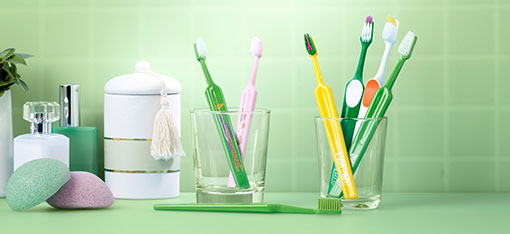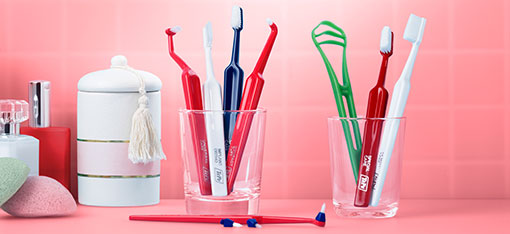It is a well-known fact that good oral hygiene is essential to maintaining oral health. The two most common oral diseases, caries and periodontal disease, are predominantly interdental diseases since the interdental area is where plaque preferably accumulates and also an area that cannot be reached with a toothbrush. Therefore, interdental cleaning in adjunct to toothbrushing are cornerstones in achieving plaque control in daily oral home care.
Scientific Articles Summarized
Several studies have compared interdental brushes and other interdental cleaning devices, especially floss, with respect to their influence on plaque and gingivitis. Patient preference is also a factor that has been evaluated. The research in favor of interdental brushes is convincing. These five studies have been summarized supporting the use of interdental brushes.
Click on subject below to read more.
Comparison of interdental brush to dental floss
Comparison of interdental brush to dental floss for reduction of clinical parameters of periodontal disease: A systematic review.
Imai PH et al.
Can J Dent Hygiene. 2012;46,no.1:63-78.
The purpose of this systematic review was to evaluate the efficiency of interdental brushes and dental floss as adjuncts to toothbrushing for reducing gingival bleeding and dental plaque. Included studies were randomized controlled trials, including split mouth and crossover trials. Four papers were included for the analysis on bleeding outcome and seven papers for the analysis on plaque outcome. The results indicate that the interdental brush is more efficient than dental floss for reducing both bleeding and plaque.
The article presents an instructive flowchart, containing practical guidelines for choosing interdental cleaning device for the patient with interdental inflammation. First, assess the patient’s level of dexterity and motivation for daily interdental self-care. If the patient has good dexterity and/or is motivated, the next step is to determine the embrasure type. For patients with type I embrasures, dental floss should be recommended. With embrasures of type II or III, the interdental brush is the correct choice.
If the patient, on the other hand, has poor dexterity and/or lacks motivation, the appropriate recommendation is interdental brushes, regardless of type I, II or III embrasures. The authors conclude that the interdental brush is an effective alternative to dental floss, for reducing interproximal bleeding and plaque in booth filled and open embrasures.
Mechanical plaque control
Efficacy of inter-dental mechanical plaque control in managing gingivitis – a meta-review
Sälzer S et al.
J Clin Periodontol. 2015 Apr;42 Suppl 16:S92-105.
This meta-review, a systematic review including only systematic reviews, compiled the effect of dental floss, woodsticks, interdental brushes and an oral irrigator used for interdental plaque removal in managing gingivitis. Six systematic reviews were included – regarding dental floss (2 studies), woodsticks (1 study), interdental brushes (2) and oral irrigator (1).
The magnitude of the effect of floss was small and unclear regarding woodsticks and oral irrigator, but for interdental brushes, it was large. The body of evidence was greatest for interdental brushes.
Besides the efficacy of the interdental cleaning device, patient compliance is also an important factor to value when choosing device. Compliance is highly dependent on preference and manual skills of the individual patient. Interdental brushes are shown to be considered easier to use by patients, than floss.
There is not one single interdental cleaning device which suits all patients and interdental spaces. Several factors need to be considered; among them scientific evidence. This meta-review concludes that there is consistent evidence for interdental brushes being the most effective devices for interdental plaque removal. They are also the most appreciated devices for interdental cleaning among patients.
Interproximal oral hygiene
A network meta-analysis of interproximal oral hygiene methods in the reduction of clinical indices of inflammation
Kotsakis GA et al.
J Periodontol. 2018 Feb 19. doi: 10.1002/JPER.17-0368.
This study aims to compare the effect, measured as gingival inflammation, bleeding-on-probing, plaque, and pocket depth, between different interdental cleaning regimes. The regimes included are flossing, powered flossing, toothpicks, toothpicks and intensive oral hygiene instructions, water jet irrigation devices, interdental brushes, gum massaging devices, toothbrush only (controls), powered toothbrush (controls), powered toothbrush and waterjet.
Network meta-analysis is the method chosen to make both direct and indirect comparisons possible among included studies and to provide information which enables ranking of the included interventions based on the set outcomes. The results are based on the 22 studies that met the criteria to be included in the analysis.
Interdental brushes displayed the best result regarding gingival inflammation, plaque reduction, and pocket reduction. Concerning bleeding on probing, toothpicks in combination with intensive oral hygiene instruction presented the best outcome. Only one study used the intervention toothpicks in combination with intensive oral hygiene instruction, and in this case, it was not possible to determine whether the actual device or the instruction part was crucial for the result. However, the authors conclude that from an individual perspective the choice of devices needs to be based on individual and clinical conditions.
Prevention of periodontitis
Primary prevention of periodontitis: managing gingivitis
Chapple IL et al.
J Clin Periodontol. 2015 Apr;42 Suppl 16:S71-6.
This is a report from the 11th European Workshop in Periodontology on primary prevention of periodontitis. The working group has focused on four different approaches: mechanical self-administered plaque control regimes, self-administered interdental mechanical plaque control, adjunctive chemical plaque control and anti-inflammatory approaches.A number of conclusions are drawn in this report. It is implied that professional oral hygiene instruction contributes to plaque and gingivitis reduction, and that reinforcement of the instruction may lead to enhanced results.
Concerning interdental brushes, they have shown the highest efficacy in plaque removal and are also shown to be the most accepted interdental cleaning devices among patients. Regarding the use of floss, most studies cannot show a general effectiveness in plaque removal or reduction of gingival inflammation. According to the working group, interdental brushes are the preferred choice for interdental cleaning. Floss can be an alternative only when sites are too narrow for the interdental brush and show gingival and periodontal health. It is stressed that any method chosen for interproximal cleaning should be preceded by professional instruction.
The effectiveness of interdental brushes
The effectiveness of conically shaped compared with cylindrically shaped interdental brushes - a randomized controlled clinical trial
Larsen HC et al.
Int J Dent Hyg. 2017 Aug;15(3):211-218.
In this randomized controlled clinical study the aim was to compare the effectiveness of conical and cylindrical interdental brushes in respect to plaque and bleeding scores. The subjects included in the study were patients enrolled in a supportive periodontal maintenance program for at least one year after treatment of periodontitis.
The patients were randomly selected to use either a conical or a cylindrical interdental brush. The right size was tried out and instructions were given on how to use the brush. The interdental brush was used from the buccal site. Plaque scores, bleeding upon probing and probing pocket depth were registered at base-line and at the 3-month follow-up. Six sites per tooth, disto-vestibular, vestibular, mesio-vestibular, disto-lingual, lingual and mesio-lingual, in the 51 participating subjects were analyzed. All approximal sites with the appropriate size for an interdental brush were included.
A statistically significant difference was shown in plaque and bleeding scores at lingual approximal sites, disto-lingual and mesio-lingual sites, due to an increase in plaque and bleeding scores at these sites during the test period in the group allocated to the conical interdental brushes. The authors declare the results as being dependent on the geometric differences in the shape of conical and cylindrical interdental brushes, in favour of the cylindrical shape.










